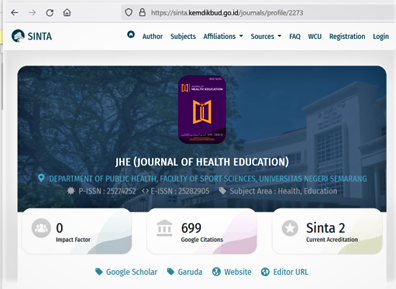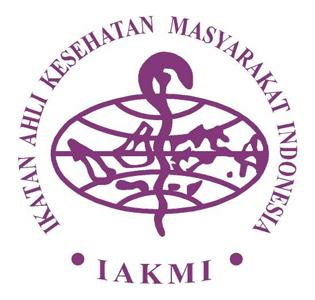Author Guidelines
JHE (Journal of Health Education) contains articles based on the result of research or equivalent to the result of research in the field of health education. It involves the research either in the school or the community. The journal accepts articles on the public health areas such as health education, health promoting schools, wellness and physical education, and health policy and program evaluation. The article published in this journal has never been published by other media.
General Rules of Writing
- Article includes title, author name(s), abstract in English, keywords, introduction, methods, results and discussions, conclusions, and references (a detailed description is in Article Writing Systematic below)
- Article can be written in Indonesian or English language with Microsoft Word/ word processor.
- Article is written with Times New Roman font, size 10, 1.5 line spacing, 2 cm margins on all edges, and the number of pages must be between 8 to 14 pages.
- Paper size is A4 in double column
- Article template is available here.
- Formulas and equations are written with Microsoft Equation
- Table title is written above the table (1 line spacing) with numerical numbering (Table 1, Table 2, etc.)
- Table is single line spacing and made without vertical borders. Source of table must be included at the bottom of the table, if the table or its content refers to literature sources. If its content contains the results of primary data analysis, then it does not need to include any source.
- Figure title is written below the figure (1 line spacing) with numerical numbering (Figure 1, Figure 2, etc.)
- Source of figure must be included at the bottom of the title, if the figure refers to literature sources. If the figure is a graph (bar, pie, line, etc.) that describes the results of primary data analysis, then it does not need to include any source.
- References are written using the American Psychological Association 7th Edition style by using a reference manager (Mendeley).
- Online submission is available here.
Article Writing Systematic
Title
- Article title is informatively and concisely written in English language with 5-12 words.
- Article title contains variable(s) studied and describes content of article.
- Article title must not contain abbreviations
- At the bottom of title, write the author's name (without academic degree), the institution name, and the institution's country.
- At the bottom of the abstract, write the corresponding author's name, institution name, address, city, province, country, postal number, and e-mail address.
Abstract and Key Words
- Abstract is written in English language, 150-200 words maximum, with structure: Background, Methods, Results, Conclusion, and Keywords
- Background clarifies major research problems briefly and ended with research objective(s).
- Methods explain research design, research instrument(s), data collection technique(s), data analysis method(s), and research procedure briefly(if possible).
- Results describe research results quantitatively (mean, standard deviations, p-value, OR/RR/RP, or other statistical values) or/and qualitatively.
- The conclusion is an answer to research objective(s) (without writing down the statistical value).
- Keywords contain basic words in the article consisting of 3-5 words.
Introduction
The introduction is fully written without subtitles in the form of paragraphs with a length of 10-15% of the overall article length. This section includes:
- Background or research rational/problems.
- Literature review (briefly).
- Research objective(s).
Methods
Methods are written with a length of 10-20% of the overall article length. This section includes:
- Research design (research type and design).
- Research instrument(s).
- Data collection technique(s) and data source(s).
- Data analysis method(s)/statistical test(s).
- Research procedure briefly (if possible).
Results and Discussions
Results and discussion are described with a length of 40-60% of the overall article length. This section includes:
- For quantitative research, this section describes the results of data analysis including statistical values, such as mean, standard deviations, p-value, OR/RR/RP, or other statistical values, along with their interpretation.
- For qualitative research, this section describes the results of the interview/focus group discussion, along with its interpretation
- It can be presented with a table or graph, to clarify the results
- This section also includes a discussion answering research problems, interpreting the findings, integrating the findings into the existing body of knowledge, composing a new theory, or modifying existing theories.
Conclusion
- It contains conclusions to answer to research problems.
- It is written without reloading the statistical value.
- It is written in the form of an essay, not in numerical form.
References
- References are fully written according to the references only cited in the article.
- References are written using the American Psychological Association 7th Edition style by using a reference manager (use Mendeley format in Ms Word)
- References must be of literature published in the last 10 years, except for historical study.
- References are at least 80% in the form of the journal article.
- References consist of at least 25 publications.
- How to write references based on the American Psychological Association 7th Edition style are as follows:
Book:
Balitbangkes. (2018). Laporan Nasional Riset Kesehatan Dasar (RISKESDAS) 2018. Sekretariat Badan Litbang Kesehatan.
Maschinen, B., Investition, A., Beschaffungen, G., Ersatzbeschaffungen, B., & Mittelherkunft, S. (2019). Guiding Principles and Framework Manual for Front-of-Pack Labelling for Promoting Healthy Diet. World Health Organization.
Thesis
Alsaddah, A. S. (2014). How Does Knowledge and Utilization of Nutrition Labels. Kent State University.
Journal article:
Budiono, I., Rahayu, T., Soegiyanto, & Kurnia, A. R. (2019). Use of “ Nutriatlet †Smartphone Application-based Personalized Nutrition Program to Improve Energy Consumption , Body Mass Index , and Body Fat Percentage among Martial Arts Athletes. Japanese Journal of Physical Fitness and Sports Medicine, 8(1), 29–35. https://doi.org/10.7600/jpfsm.8.29
Kandarina, B. J. I., Hatriyanti, Y., Rahayujati, T. B., & Kurnia, A. R. (2020). Development of School Canteen and School Gardens Guidelines as Prevention against Cardiovascular Disease in Kulon Progo, Yogyakarta, Indonesia. Journal of Community Empowerment for Health, 3(1), 41–48.
Talati, Z., Egnell, M., Hercberg, S., Julia, C., & Pettigrew, S. (2019). Food choice under five front-of-package nutrition label conditions: An experimental study across 12 countries. American Journal of Public Health, 109(12), 1770–1775. https://doi.org/10.2105/AJPH.2019.305319
Conference proceedings:
Prameswari, G. N., & Kurnia, A. R. (2018). Qualitative Study of Exclusive Breastfeeding Succeded among Working Mother. In International Seminar on Public Health and Education 2018 (ISPHE 2018). Atlantis Press.
Website:
Hamdani. (2020). UNNES Kerjasama Dengan Puskesmas Jatisrono I Wonogiri Terbitkan Booklet Siaga Corona Alias BOSICO, Ternyata Untuk Mencegah Penyebaran COVID-19. Joglosemarnews.com. https://joglosemarnews.com/2020/10/unnes-kerjasama-dengan-puskesmas-jatisrono-i-wonogiri-terbitkan-booklet-siaga-corona-alias-bosico-ternyata-untuk-mencegah-penyebaran-covid-19/






